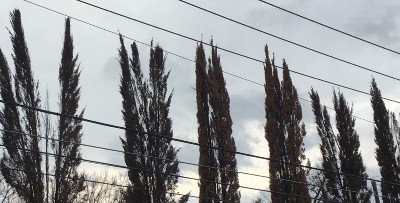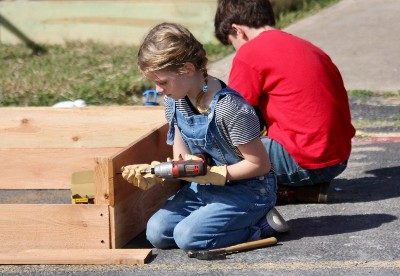A 4-H volunteer gets to work with a screw-gun photo: Renee Studebaker
Positive Energy Fuels the
Move of a School Garden
by Renee Studebaker
When my principal told me that Smith Elementary’s construction plans had gone awry and that our school garden had to be bulldozed right away to make room for a new building, I felt like I’d been punched in the stomach. I wanted to cry, but I didn’t.
The next day, third-grader Julie Hora had a similar reaction when I shared the news in her garden class, but she didn’t hold back: “OH NOOO! This is terrible. What about the baby snap peas and all the little green tomatoes?”
When she started tearing up, I thought I was going to lose it too. “This is a sad thing, but it will be OK. We’re going to try to rescue as many plants as we can,” I said, “and we will build another garden.”
Over the next four days, I worked with about 20 Smith garden students, 15 4-H volunteers from the Green Corn Project, and two gardening friends (thank you, Diana and Molly!) to move five raised bed frames and about three yards of reusable garden soil to a temporary garden space about 200 yards away from the path of the bulldozers.
We also dug up a fig tree and a pear tree, as well as dozens of vegetables, herbs and flowers. We replanted them in whatever receptacles we could round up – trash cans, plastic pots, large mixing bowls, and small garden carts.
Then we built two new cedar raised beds and loaded them with a yard of fresh soil donated by the Green Corn Project. Shovels, wheelbarrows, and determined gardeners were flying back and forth in a haze of garden dust. Somebody brought doughnuts to help fuel the effort. Whirring screw guns provided background sounds.
At the time, I was grateful for the help, but I couldn’t help wondering whether the plants would survive the experience. To say that we were a little rough on the plants would be an understatement. But we got it done, and we met our deadline.
After everyone had packed up their garden tools and gone home, I stood for a moment surveying the empty spaces in the huge garden where I had been teaching gardening and cooking classes for the past eight years.
A black swallowtail butterfly flew by, pausing briefly where the bed of flowers and herbs used to be. Sorry, garden friend. We had to move your fennel. I hope you’ll come visit us in our new space.
And then I couldn’t hold it back anymore. I sat on the ground and cried.
That was two months ago, and now I’m happy to report that our hastily replanted garden is looking pretty good.
The two mature Sungolds we dug up and placed in 10-gallon pots not only survived, they also produced 7 or 8 pints of tomatoes from mid-October through November. The eggplants and peppers also survived. We made ratatouille in the garden with the harvest.
I had worried that the romaine lettuce seedlings might not survive their rough treatment, but they did. I’m sure it helped that we immediately replanted them in a new raised bed and then watered them almost every day for the next two weeks.
The garden students have also adapted well to our temporary arrangements. The most often asked question is “Will the fig tree live?”
A simple scratch test on the fig’s trunk shows green, so I assure them the tree is alive, but it needs time to recover. During the move, volunteers had to chop several of its primary roots to get it out of the heavy clay soil.
To make matters worse, we didn’t have a pot big enough to fit the tree, so we shoved it into a plastic trash can. Two days later, all its leaves dropped off. We’re hoping to keep it alive until August when it can be properly planted in a new permanent garden space that is being planned by the school’s building contractors.
The weirdest outcome? The radishes. Some students were feeling attached to the baby radishes they had grown from seed and didn’t want to leave them behind to be squashed by the bulldozers.
I acquiesced even though I thought it would be better to start over with new seeds. Out of about 20 transplanted radishes, only three died. The survivors were oddly shaped though, and their roots were gnarly, probably because their tap roots had been disturbed. We laughed at how funny they looked, and then chopped them up for our garden salads.
The most dubious outcome? The snap peas. Julie claps her hands and does a little happy dance every time she inspects the snap pea vines. I don’t remind her that the biggest vines, the ones that are now blooming and setting little pea pods, may not be the same plants she dug up and replanted. The same day we transplanted pea vines, we also planted more seeds, as a backup.
Last week, Kane Pornphet, a fifth grader who’s new to the garden class, looked around at the lush growth of the kale, the collard greens, and the Swiss chard in our raised beds. “Everything is so big,” he said. “I didn’t know plants grew this fast.”
Yes, indeed, they do grow fast. And that’s a very good thing. ❦






